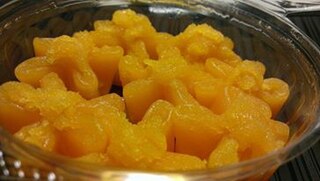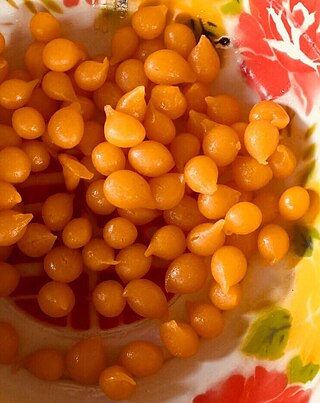
Thai cuisine is the national cuisine of Thailand.

Khanom Buang, known as Thai crepes in English. Kanom Bueang is an ancient Thai snack known as crispy pancakes in English. It is a popular form of street food in Thailand. These crepes resemble tacos. Khanom bueang are usually first topped or filled with meringue, followed by sweet or salty toppings such as shredded coconut, Foi Thong, or chopped scallions.
Maria Guyomar de Pina, Thao Thong Kip Ma, was a Siamese woman of mixed Japanese-Portuguese-Bengali ancestry who lived in Ayutthaya in the 17th century. She became the wife of Greek adventurer Constantine Phaulkon.

Khanom chan is an ancient Thai khanom, or dessert, made of tapioca flour, rice flour, and coconut milk, among other ingredients. Originating from the Sukhothai Period, the dessert is a staple snack in Thai cuisine, and Thai people usually prepare it for auspicious ceremonies.

Bua loi or bua loy is a Thai dessert. It consists of rice flour rolled into small balls, and cooked in coconut milk and sugar. Some Bua loi also adds sweet egg into the recipe. It was inspired by Tangyuan, a Chinese dessert that is traditionally eaten around the Lantern festival. Bua Loi is also traditionally eaten during the Dongzhi Festival in Thailand, which is a festival for the Chinese-Thai bloodline. There are a variety of versions of Bua loi such as ones that use food coloring instead of natural color, use soy milk instead of Coconut cream, add sliced pumpkin inside the rice balls, et cetera. There are other types of Bua loi from other countries such as China, Japan, Indonesia, Myanmar, Philippines, Southern Vietnam and Malaysia. 1 cup of Bua Loy has total calories of 295.5 kilocalories, protein of 10.4 grams, carbohydrate of 6.3 grams, and fat of 25 grams.

Thong yip or pinched gold egg yolks is one of the nine auspicious traditional Thai desserts. It is usually made for important occasions and ceremonies such as weddings, ordinations, and housewarmings.

Thong yot, also known as "gold egg-yolks drops", is an ancient Thai dessert and one of the nine auspicious traditional Thai desserts. Thong yot originated in Aveiro District, Portugal. Thong yot was adapted from ovos moles de aveiro, a Portuguese dessert, by Maria Guyomar de Pinha, who was appointed as a cook in the palace in the period of King Narai of Ayutthaya. Thong yot is made from egg yolks, flour and sugar.

Khanom thuai talai, usually shortened to khanom thuai (ขนมถ้วย), is a Thai dessert made from rice flour, coconut milk and sugar. Its name is derived from the small ceramic cups in which the dessert is cooked and distinctively served, which are called thuai talai. Ingredients may also include salt, eggs and pandan essence.
Khanom khai, also known as khanom bulu, is a Thai dessert. It is a popular Thai snack because of the size and its palatable taste. Khanom means 'dessert' and khai means 'egg'. Khanom khai is made from egg, sugar and flour. It is crispy on the outside and soft on the inside. The taste of the dessert is similar to cake, whereas its texture is rougher because of the different types of flour and the different proportion of ingredients. Traditional khanom khai has the scent of egg after baking in charcoal stove.

Khanom mo kaeng is a traditional Thai dessert. It is similar to an egg custard or a kind of flan. Khanom mo kaeng is made with coconut milk, eggs, palm sugar, white sugar, salt, shallots and a bit of oil. There are different variations of khanom mo kaeng. The kind of starch that is used is usually taros, but sometimes are used hulled mung beans, lotus seeds, sweet potatoes, or other starches.

Thong ek, also known as "wheat flour dumplings with egg yolks", is one of the nine auspicious traditional Thai desserts. It is a golden sweet carved as various types of flowers decorated with a piece of gold leaf on top, popularly served in very significant occasions such as career advancement ceremonies.
Cha mongkut is a name of one of the traditional Thai desserts. It is similar to kalamae and is made of rice flour and glutinous flour mixed with green bean flour, and is stirred with coconut milk and sugar until it becomes sticky; it is typically sprinkled with chopped roasted peanuts on top or stuffed with melon seeds. Traditionally, they are cut into bite-size pieces and wrapped with banana leaf. Moreover, the aromatic scents of the dessert are given by fresh flowers such as Kesidang, Ylang-Ylang, Damask rose, and Jasmine with boiled water, which is used to squeeze coconut milk. Cha mongkut is easy to keep and does not need to be stored in a refrigerator.

Khanom babin, also spelled as kanom babin, is a popular Thai dessert that comes from Ayutthaya. It is made from young coconut, rice flour, coconut milk, sugar and egg.

Khanom krok bai toei or Khanom krok Singapore is a Thai dessert created by Thai people; the name khanom krok Singapore came from one of the main ingredients, tapioca starch. Thai people formerly called tapioca flour "Singapore flour", hence khanom khrok Singapore; the word khanom means dessert in Thailand. This Thai dessert is rather hard to find at present, found at some Thai dessert shops, some famous markets or department stores such as Siam Square market. Khanom khrok bai toei is shaped like a flower or a small dish, depending on the indented frying pan used to make it. It is usually a fresh green color which comes from pandan leaves. Sometimes, pastry chefs use parts of other plants instead of pandan leaves such as the blue butterfly pea flower, so this dessert can have other colors.
Khanom bodin is a traditional Thai Muslim cake, believed to have originated from Portuguese desserts like other Thai desserts such as thong muan, thong yip, thong yot, foi thong, luk chup, khanom mo kaeng or khanom farang kudi chin.
Khanom khai pla is a type of Thai dessert. It can be considered as a rare and little known dessert.
Khanom keson lamchiak is a kind of Thai dessert. It can be considered as a rare and little known dessert.

Bulan dan mek is one of the traditional Thai desserts inspired by royal songs in the reign of King Rama II of Chakri Dynasty, 1767-1824. It is a small dessert in which the center is a circular dimple with a yellow color and a bluish-purple surrounding skin.
Khanom met khanun is traditional Thai dessert dating back to the Ayutthaya period. It is made from a mixture of sweet cooked bean and coconut paste, which is dipped in blended egg yolk and then dipped in hot syrup. The dessert has a yellow-golden appearance and is a bit soft and sticky when chewed. It is one of the nine auspicious Thai desserts served in Thai wedding traditions, religious observances and as a snack.















